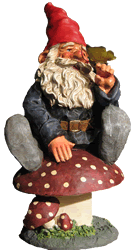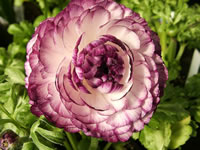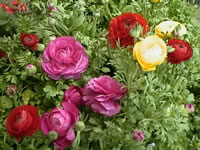How to Grow and Care for Persian Buttercups
Ranunculus asiaticus
            
|
Persian Buttercups are frost tender perennial tubers that are only hardy in zones 8-10,
so they are most often grown as annuals.
They provide a continuing display of beautiful 3"-5" Camellia-like flowers atop branched, 8"-18" stems,
from late spring through mid summer.
They are well suited plants for growing in containers.
 |
Growing Requirements for Persian Buttercups
Ranunculus asiaticus should be grown in full sun except in warmer climates
where it will need partial or light shade.
In zones 8-10, they can be grown in the garden year round.
In cooler regions they can be grown in containers and brought in during the winter,
the tubers can be dug up from the garden and stored as with Dahlia plants...
or they can be treated as an annual and simply tossed in the compost pile.
Plant Persian Buttercup tubers 2" deep and 6"-8" apart, with the 'spider legs' pointed down.
They require a light, rich, sandy soil with near perfect drainage, to prevent root rot.
Ranunculus tubers can be planted in the garden as soon as all danger of frost has passed.
Water sparingly until the new foliage emerges, then keep evenly moist.
When the first buds appear, start feeding with a ½ strength, liquid fertilizer every time you water.
|
Keep the soil evenly moist until growth slows in mid summer, then let the soil dry, as the tubers go dormant.
After the foliage yellows, dig the tubers and removes spent foliage before drying and placing in vermiculite or dry peat moss.
Store in a cool, dry location until spring.
Remove spent blooms promptly.
|
|
Persian Buttercups are succeptible to attacks from aphids
and are considered a delicasy by slugs and snails.Propagating and Growing Persian Buttercups from Seed
Persian Buttercups can be propagated by dividing the rhizomes and removing offsets in the fall.
Ranunculus seeds must be sown fresh, from the current year.
For spring blooms, sow fresh Persian Buttercup seeds indoors in mid September.
Maintain a temperature within the growing medium of 70° F.
Germination takes 10-15 days.
Once seedlings have 5-6 true leaves, transplant 4 or 5 plants per 6" pot, and keep them at 50° at night.
Move to the garden when all danger of frost has passed.
|
|
Persian Buttercups
Ranunculus asiaticus

 |
|
|
|
Search The Garden Helper:


